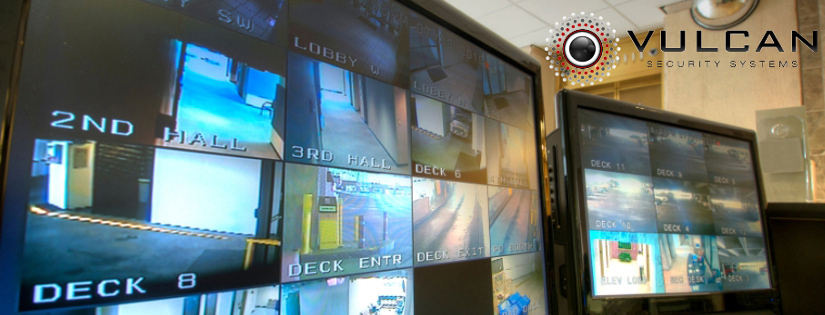Thermal cameras, also known as thermal imaging devices, are being deployed by healthcare providers in Alabama, across the US, (and beyond) as an initial screening tool for evaluating surface body temperature. If a person’s body temperature is above the provider-defined screening threshold, that individual can be selected for further screening.
In this article, we provide a detailed look at how thermal cameras work, how they can be used as an initial, discrete screening tool in medical and dental practices, skilled nursing facilities, and other healthcare settings.
Before we get into the details, imagine this scenario:
A patient arrives at your dental office and opens the front door. A mobile stand with a laptop and a Mobotix thermal camera has been placed just beyond the door where a dental assistant is monitoring each arrival. The camera is positioned to read the surface body temperature of the patient at a point just above the patient’s eye.
If the camera detects a temperature of less than, say, 99.0 F, the patient moves on toward the reception desk to check-in.
If the camera detects a temperature of 99.0 F or higher, the dental assistant uses a non-contact infrared thermometer or a clinical grade contract thermometer to take a second reading. If the thermometer verifies the higher body temperature, the assistant might do a simple risk assessment questionnaire to see if there might be an explanation for the higher body temperature (such as recent exercise or even extended time outdoors on a hot Alabama July day just before arriving). The patient could be asked to reschedule and referred to a medical provider for further assessment.
This, or a similar approach to initial screening can be implemented in many healthcare related settings, such as medical specialty practices (dermatology and orthopaedics, in particular) and physical therapy.
For healthcare providers more likely to have patients who arrive with an illness or condition that is more likely to include fever as a symptom, a similar approach can be used to determine whether the patient arrival needs to be immediately isolated from other patients or can be directed to a more general waiting room with other preventive measures in place to minimize spread of respiratory infections.
In fact, thermal cameras are currently in use at many healthcare provider facilities across the US, including Chicago hospitals.
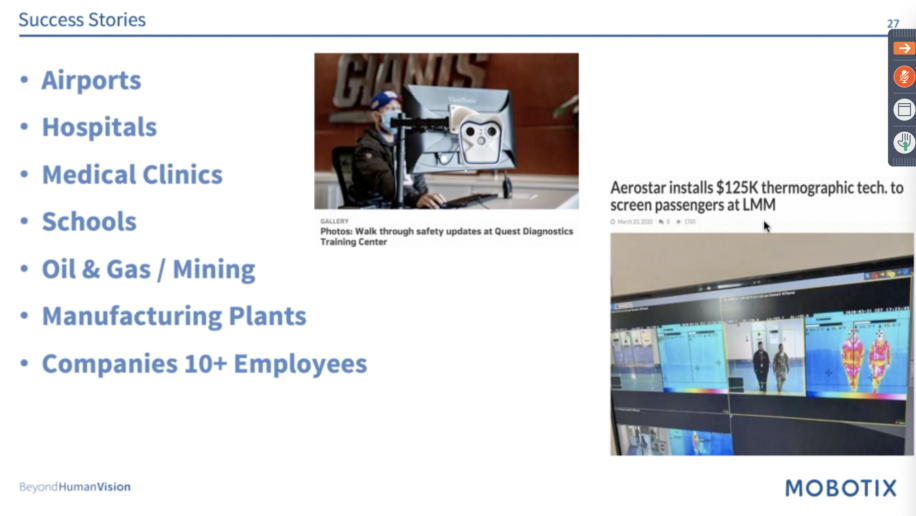
First Question: Are Thermal Cameras Approved by FDA for Body Temperature Screening?
The U.S. Food and Drug Administration (FDA) currently recognizes the accuracy of properly calibrated and properly used thermal cameras in measuring surface skin temperature of individual persons as a screening tool (not for diagnostic purposes).
FDA resource page: https://www.fda.gov/medical-devices/general-hospital-devices-and-supplies/thermal-imaging-systems-infrared-thermographic-systems-thermal-imaging-cameras
In April 2020, the FDA released nonbinding recommendations and guidance to its staff concerning concerning the use of thermal cameras and other “telethermographic sysems” for body temperature measurement during the COVID-19 public health emergency. This guidance is available here:
Link to FDA Guidance Policy: https://www.fda.gov/regulatory-information/search-fda-guidance-documents/enforcement-policy-telethermographic-systems-during-coronavirus-disease-2019-covid-19-public-health
Our preferred thermal camera supplier, Mobotix, has been especially helpful in providing detailed resources on how to calibrate and deploy Mobotix cameras and related thermal screening technology to properly measure surface body temperature in context of healthcare settings, consistent with the US FDA guidance.
In the past few months, Vulcan Security Systems LLC has fielded a number of calls from healthcare providers, businesses, and Alabama school systems interested in using thermal cameras to assist in reopening their operations and minimizing the risk of need to fully shutdown due to a COVID-19 outbreak at their facilities. We have a long track record in installing and monitoring thermal cameras as part of a more general premises security program so designing and implementing thermal cameras in healthcare settings has been straightforward.
This article is based on the FDA and Mobotix resources, as well as VSS’s experience with Mobotix thermal cameras in myriad business contexts.
In the context of healthcare provider settings, it’s important to note at the outset that thermal cameras, like those made by Mobotix, are not devices that are typically regulated by the FDA. As a result, some healthcare providers might be concerned about using “off-the-shelf” thermal cameras as a screening tool. Due to the public health emergency and minimal associated risks, the FDA has relaxed the limitations that might otherwise exist with regard to use of thermal cameras not specifically approved for use in adjunctive diagnostic screening by healthcare providers and in workplace settings.
In fact, the FDS says that the goal is to expand the range of thermal devices that can be deployed, to help mitigate against “shortages of temperature measurement products such as thermometers.”
The FDA’s Nonbinding Recommendations guidance document specifically states that the enforcement policy set out in its guidance:
applies to telethermographic systems that are intended for adjunctive diagnostic screening during the COVID-19 pandemic. These products may be [regulated devices], or products that normally are not considered devices under the FD&C Act, but that may be used for a medical purpose during COVID-19 pandemic to address availability concerns of such products.”
FDA COVID-19-Related Guidance Documents for Industry, FDA Staff, and Other Stakeholders.
In a nutshell, the FDA’s policy guidance is such that non-medical thermal cameras are appropriate for use as an initial screening tool for non-diagnostic purposes, provided a secondary evaluation method is used if the camera signals elevated surface temperature, AND the camera’s quality has been tested to meet required thresholds, is properly calibrated and implemented, and the manufacturer complies with labeling requirements. We will cover these requirements in more detail later in this article. Mobotix thermal cameras meet these requirements when installed and used properly by the healthcare provider.
Why Are Thermal Cameras Useful For Initial Screening?
Thermal Screening Can Be Discrete and Remote
First of all, the initial camera screening is discrete and “remote,” meaning no physical contact between the screening monitor and the person is required.
Unlike when body temperature is measured by thermometer (even the non-contact IR types), the person who is conducting first level screening can be physically distant, separated by Plexiglass or other barrier, or even in a different room.
Individuals who do not register a temperature above the defined threshold are admitted without disturbance.
Those who do trigger a monitoring alert can be discretely directed to the next evaluation point without necessarily raising attention. There’s no need for audible alarms or flashing lights.
Thermal cameras that are configured to read thermal only (optical lens disabled) also provide greater privacy to those going through the screening checkpoints.
Thermal Cameras Are Efficient Level 1 Screening Tools
Thermal camera screening can be performed quite rapidly. One person passes through the check-point at a time, there’s a brief pause to allow the camera to “read” the right spot around the eye, and then individual moves on. It takes about 1-1/2 to 2 seconds for the Mobotix thermal sensor to register the surface temperature.
Even if you’re screening a steady flow of individuals (such as at a hospital entrance or school), the basic requirements are that one person enters, pauses at the designated spot for less than 2 seconds and then proceeds, as directed.
Each person being screened needs to remove glasses, hats or scarves that might obstruct the camera sensor’s “view” of the face.
Note: You cannot screen multiple individuals at the same time. It is necessary to have the individual pass through the screening point separately, just like at TSA airport security checkpoints.
Healthcare Settings Have Special Privacy Requirements: Mobotix Video Cameras Are Designed, Built and Tested for Security
Mobotix cameras are German-engineered AND German-made. There are no Chinese parts.
Mobotix cameras are NDAA-compliant and have received numerous security certifications and awards. [NDAA refers to the National Defense Authorization Act.]

Mobotix is committed to rigorous penetration testing by third-party cybersecurity firms of all cameras and ancillary technology (including firmware). All Mobotix cameras have received high cybersecurity scores by the German SySS penetration testing firm.
Mobotix cameras also allow users to enable intrusion detection, limit log-in attempts, block IP addresses, and prohibit access by web-crawling bots. Video recordings and any messages can be encrypted for further security and privacy protection.
For added security features, Mobotix cameras can be programmed to send private alerts to security guards, nurses, or other personnel, if a defined trigger event occurs, and automatically lock-down doors when paired with access control technology.
The Mobotix camera is essentially a Linux server with a lens.
Ben Conway, Business Development Manager: Southeast, Mobotix USA.
The cameras can be set up on a separate, standalone VLAN, to avoid congestion on the main network and to provide an added barrier for security.
A Quick Primer on Thermal Camera Technology
Thermal cameras read the electromagnetic radiation emitted from a person. Variations in heat intensity across the field of view is mapped using color, as you see in this image.
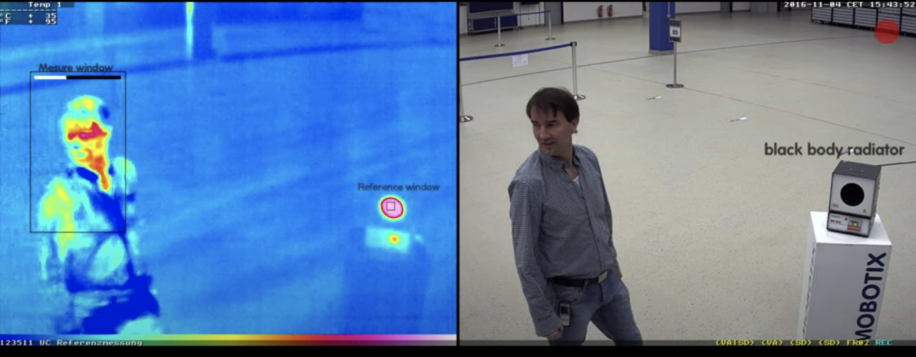
The above-image is from a Mobotix demonstration image with a dual-sensor (thermal and optical lens) showing a large measurement window used with a black body radiator device for reference.
Best Practices for Using Thermal Cameras in a Healthcare Setting
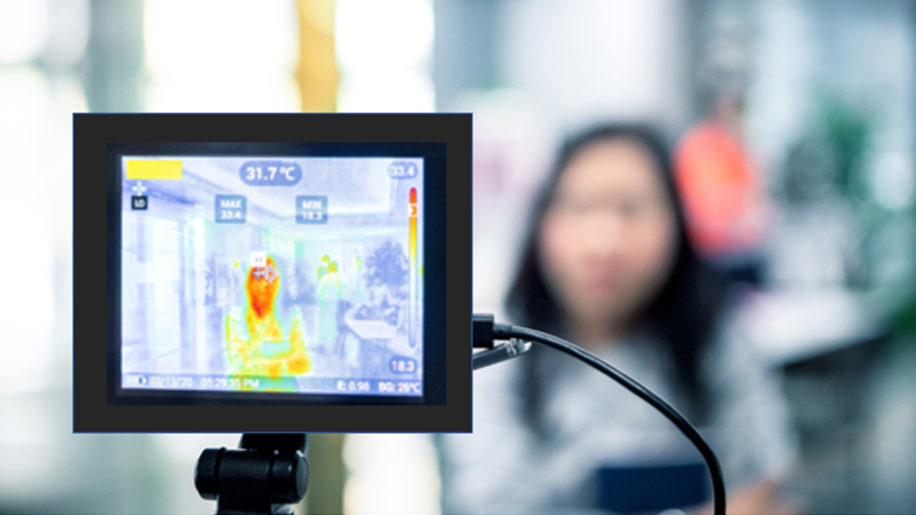
The FDA has provided guidance on the proper use of thermal devices, like thermal cameras, for initial temperature measurement in settings where a large number of people need to be screened. In this section, we’ll take a look at the FDA’s guidance , along with Mobotix’s best practices to optimize use of Mobotix thermal cameras.
The camera should be set up so there’s approximately 7 feet distance between the camera and the individual being screened.
As noted above, individual subject must be screened one at a time and there should be a pause of approximately 2 seconds to allow the camera sensor to capture the heat intensity in the designated field for measurement. You don’t want two people walking through the screening point at the same time. The camera needs a clear, unobstructed view of the face of the person who is being screened.
Extensive validity and reliability testing of thermal imaging for elevated body temperature screening has shown that the most reliable point for measuring temperature in this context is around the medial canthus.
Accordingly, the individual being assessed should remove glasses, hats, and scarves to allow the lens to have a clear view of the face, particularly around the eyes. See Mobotix slide below for a visual illustration of this location.
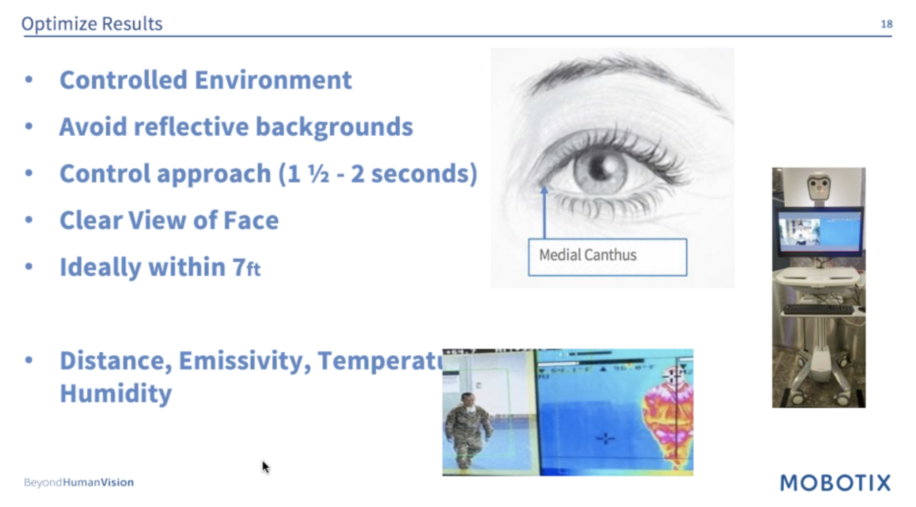
It’s important to note that measurement validity can be adversely affected by external factors, such as recent exercise and even room temperature and humidity levels.
Ideally, the following factors should be considered before a person is screened to minimize the chance of invalid initial measurement (or intentional manipulation to “pass” the first-level screening. If that’s not possible due to the need for rapid screening before facility access, then these factors should be considered, depending on the results of the thermal camera assessment.
- How long has the person been in the measurement room before assessment? Ideally, the time should be around 15 minutes to allow acclimation to the test room conditions.
- Is the person’s face dry or moist from perspiration or rain?
- Has the person used a face wipe or cold/hot compress in the past 15 minutes?
- Is the individual drinking a hot/cold beverage in close proximity of time before assessment?
- Has the person been exercising, walking outdoors on a hot or cold day, or seated in a cold or hot waiting room?
Conditions of the Measurement Room
In addition to the individual human factors that can impact surface body temperature, the room conditions are also a factor in reliability and validity of results.
The FDA has offered specific recommendations for room conditions to achieve best outcomes when using thermal cameras. These recommendations include:
- Controlled temperature in the range between 68-76°F.
- Relative humidity level of 50% or lower (but not below 10%)
- Keep waiting area and measurement point away from direct sunlight and any radiant heat source
- Avoid placing camera and waiting area in the line of HVAC ventilation drafts or outside breezes that can cause variability in temperature
- Reflective surfaces like glass, mirrors, and metallic surfaces can impede results, so keep this out of the background of field of view of the camera.
- “Strong lighting” can also affect results, so avoid use of incandescent, halogen and quartz lighting
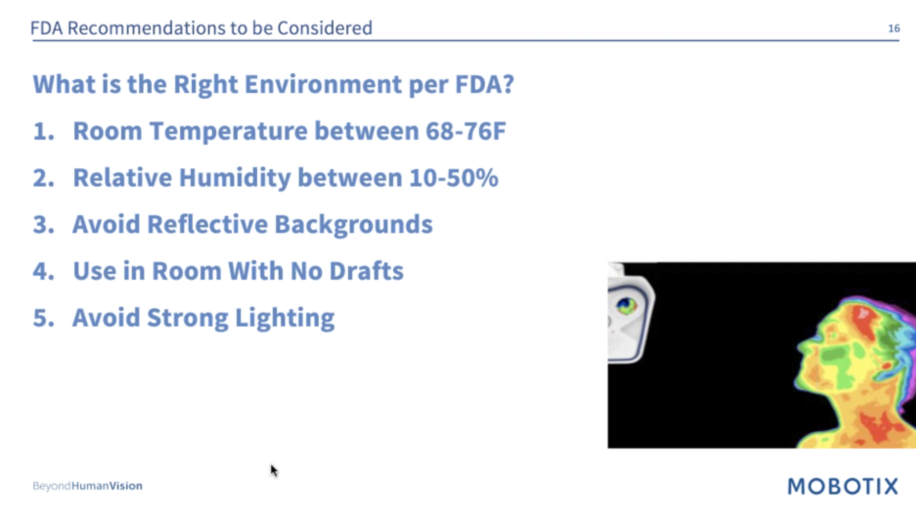
Thermal Camera Calibration
The reliability and validity of thermal camera measurements will only be as good as the quality of the camera, the camera’s proper calibration, and proper use by trained personnel.
The training itself is easy, once the camera is set-up and properly calibrated. You will need to define the appropriate protocols for your healthcare screening environment based on whether you are a medical practice with a steady but somewhat intermittent stream of visitors, a high-volume facility like emergency room or hospital, or a facility like a physical therapy site or public-facing lab testing site.
Quality Thermal Camera That Meets FDA Performance Guidelines
FDA performance guidelines suggest using devices that produce “uncertainties less than or equal to +/- 0.5°C (+/- 0.9°F over the temperature range of at least 34-39°C (93.2-102.2°F).” Mobotix thermal cameras comply with this guideline. Some may not.
Black Body Temperature Reference Source
The FDA recommends the use of a black body temperature reference source along with the thermal camera to provide constant evaluation of the accuracy of temperature readings. The use of a black body radiator reduces the need for frequent re-calibration of the camera.
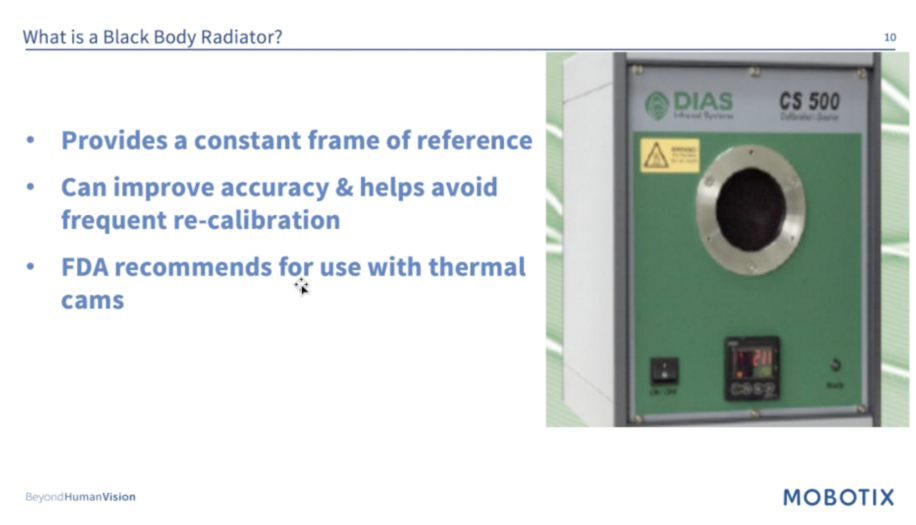
Contact Vulcan Security Systems for Free Initial Consultations
Vulcan Security Systems is based in Birmingham, Alabama and serve business and industrial clients across Alabama. With the massive increase in interest in thermal cameras across the U.S., we’ve also begun consulting on thermal camera deployment at medical practices and business facilities outside of Alabama.
Phone: 205.290.9404
Email: info@vulcansecuritysystems.com
